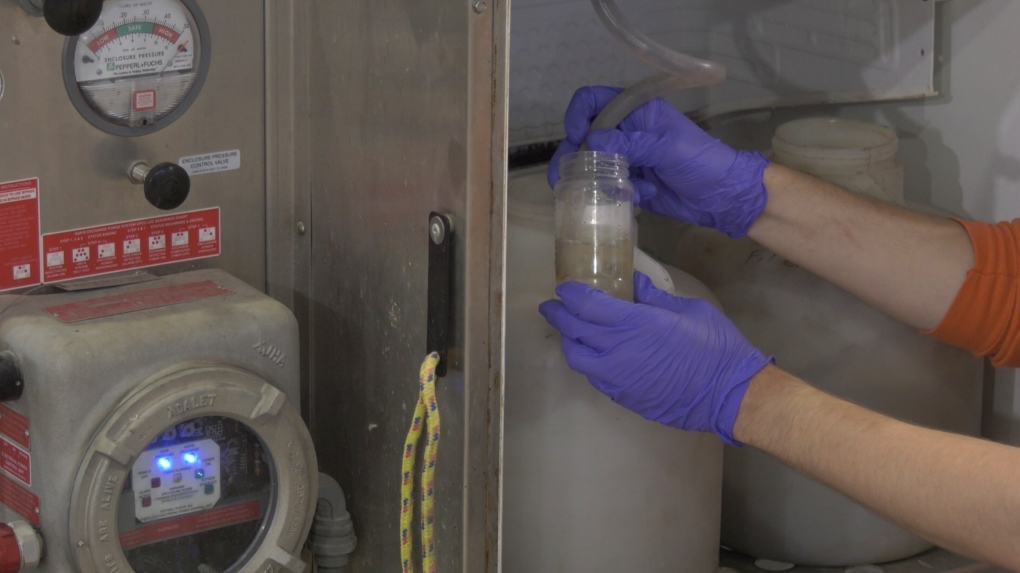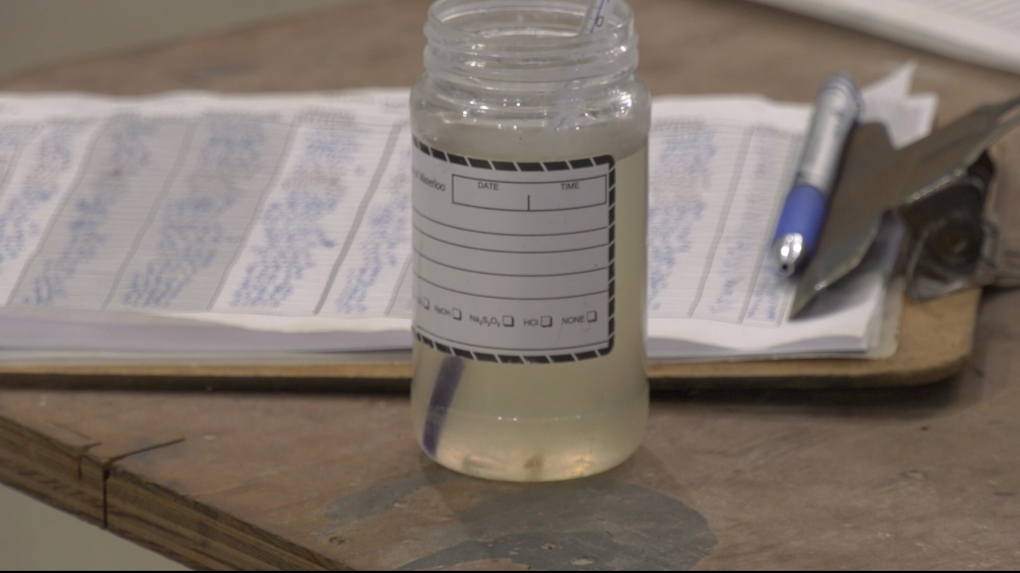A look inside Waterloo Region's wastewater surveillance program
You may not have heard as much about the spread of COVID-19 lately, but the threat remains.
Wastewater testing continues in Waterloo Region and over the last several weeks, it’s been picking up increased signals of the virus.
To better understand how the data is gathered and what it reveals, CTV News got an inside look at the process.
The journey starts with a visit to ground-zero for Waterloo Region’s COVID-19 wastewater surveillance, the Kitchener Wastewater Treatment Plant.
“Samples are collected five days a week during the workweek,” wastewater engineer Kristina Lee explains.
It may not looks like much, but the human wastewater contains a wealth of information, revealing what’s happening that day.
“We get snapshots of the wastewater over the 24-hour period, and it collects them in a large container,” Lee says.
 A human wastewater sample is collected at the Kitchener Wastewater Treatment Plant. (Spencer Turcotte/CTV Kitchener)
A human wastewater sample is collected at the Kitchener Wastewater Treatment Plant. (Spencer Turcotte/CTV Kitchener)
SAMPLES ANALYZED IN LAB
From the treatment plant, the samples are taken to the University of Waterloo, where experts in watershed management have taken on a new role.
“We're actually a fisheries toxicology lab,” says Mark Servos, Canada Research Chair in Water Quality Protection. “We study pollution in the Grand River.”
The testing process is extensive. A sample is concentrated by settling the virus with a chemical, and then concentrated further using a centrifuge.
 It may not looks like much, but human wastewater contains a wealth of information. (Spencer Turcotte/CTV Kitchener)
It may not looks like much, but human wastewater contains a wealth of information. (Spencer Turcotte/CTV Kitchener)
After that, lab staff take the samples and replicate them.
“That will double the amount of RNA turning into DNA," explains Rachel Dawe, wastewater surveillance lab manager.
Finally, the sample is amplified before the data is processed.
“That's going to allow us to quantify how much was in the actual original sample,” Servos says.
CURRENT PICTURE
The process allows the scientists to see if coronavirus is still circulating the community.
The latest public health wastewater surveillance data shows signs of the virus have increased locally over the last month.
“We're starting to see a slight increase already at the end of August,” Servos says.
 Rachel Dawe, wastewater surveillance lab manager, analyzes a sample. (Spencer Turcotte/CTV Kitchener)
Rachel Dawe, wastewater surveillance lab manager, analyzes a sample. (Spencer Turcotte/CTV Kitchener)
The wastewater signal has been dominated by the XBB variant of Omicron, but it’s not alone.
“EG.5 has been here for weeks now in the region, absolutely. It's in the wastewater. It's been here,” Servos explains.
The UW lab says they’re closely monitoring the different variants emerging, worried that more will arise as we near the colder months.
“We're concerned that we're going to see a continuing trend,” Servos says.
With policies and behaviour around COVID-19 testing changing dramatically during the pandemic, public health will continue to look at wastewater to get a clearer picture of what’s happening with COVID-19.
Waterloo Region Public Health publishes wastewater surveillance data weekly on its COVID-19 dashboard.
CTVNews.ca Top Stories

Trudeau noncommittal on expanding rebate beyond 'working Canadians'
Prime Minister Justin Trudeau does not appear willing to budge on his plan to send a $250 rebate to 'hardworking Canadians,' despite pressure from the opposition to give the money to seniors and people who are not able to work.
'Mayday!': New details emerge after Boeing plane makes emergency landing at Mirabel airport
New details suggest that there were communication issues between the pilots of a charter flight and the control tower at Montreal's Mirabel airport when a Boeing 737 made an emergency landing on Wednesday.
Cucumbers sold in Ontario, other provinces recalled over possible salmonella contamination
A U.S. company is recalling cucumbers sold in Ontario and other Canadian provinces due to possible salmonella contamination.
Latest updates: Tracking RSV, influenza, COVID-19 in Canada
As the country heads into the worst time of year for respiratory infections, the Canadian respiratory virus surveillance report tracks how prevalent certain viruses are each week and how the trends are changing week to week.
Weekend weather: Parts of Canada could see up to 50 centimetres of snow, wind chills of -40
Winter is less than a month away, but parts of Canada are already projected to see winter-like weather.
W5 Investigates A 'ticking time bomb': Inside Syria's toughest prison holding accused high-ranking ISIS members
In the last of a three-part investigation, W5's Avery Haines was given rare access to a Syrian prison, where thousands of accused high-ranking ISIS members are being held.
Federal government posts $13B deficit in first half of the fiscal year
The Finance Department says the federal deficit was $13 billion between April and September.
Armed men in speedboats make off with women and children when a migrants' dinghy deflates off Libya
Armed men in two speedboats took off with women and children after a rubber dinghy carrying some 112 migrants seeking to cross the Mediterranean Sea started deflating off Libya's coast, a humanitarian aid group said Friday.
Nick Cannon says he's seeking help for narcissistic personality disorder
Nick Cannon has spoken out about his recent diagnosis of narcissistic personality disorder, saying 'I need help.'

































